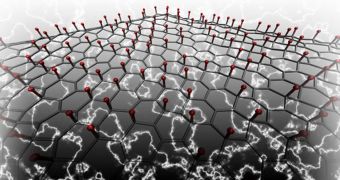In a first-of-its-kind achievement, investigators at the Stanford University were recently able to introduce a property called piezoelectricity into a nanoscale material. The substrate they selected was graphene, one of the most remarkable compounds in the world.
Graphene is a 2D carbon compound that boasts a hexagonal lattice structure. It has very unusual physical and chemical properties, can conduct electricity better than copper, and heat better than anything else. It is also the strongest material ever developed.
Within a few years, experts want to replace silicon with graphene in most electronic devices. The material was first obtained at the University of Manchester in 2004, and won the research team that synthesized it the 2010 Nobel Prize in Physics.
Piezoelectricity is a property exhibited by certain crystals and ceramic materials, which enables them to produce a small electrical current when they are deformed through mechanical forces. A piezoelectric material is generally used to create sparks in lighters.
In the new study, the Stanford team managed to introduce piezoelectricity in graphene by depositing lithium, hydrogen, potassium and fluorine atoms on one side of a graphene sheet.
This achievement marks a significant milestone in scientists' efforts to introduce a significantly-higher degree of control in nanotechnology.
Details of the new research appear in a paper published in the latest issue of the journal ACS Nano.
A remarkable thing about piezoelectric materials is that the effect works both ways – either twist the compound to get electricity, or apply an electrical current to change the material's shape. Being able to control the form a nanomaterial takes is a dream come true for engineers.
“The physical deformations we can create are directly proportional to the electrical field applied and this represents a fundamentally new way to control electronics at the nanoscale,” Evan Reed explains.
“This phenomenon brings new dimension to the concept of 'straintronics' for the way the electrical field strains – or deforms – the lattice of carbon, causing it to change shape in predictable ways,” adds the expert, who was the senior author of the study.
He also holds an appointment as the head of the Materials Computation and Theory Group at Stanford.
“Piezoelectric graphene could provide an unparalleled degree of electrical, optical or mechanical control for applications ranging from touchscreens to nanoscale transistors,” adds the first author of the paper, Stanford postdoctoral researcher Mitchell Ong.

 14 DAY TRIAL //
14 DAY TRIAL //